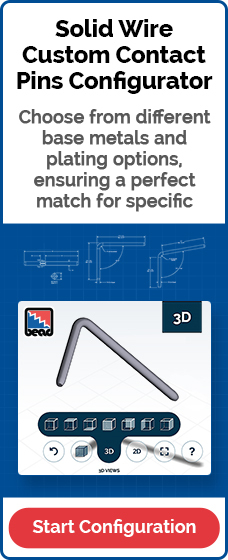Manufacturing companies rely on various forming methods to manipulate the size and shape of metal. While there are several such methods in the industry, swaging is one of the oldest used. Similarly, metal stamping is another well-known industrial process used for metal forming and has evolved over time.
The Swaging Process
Swaging is a method used to move the shape of metal through cold forming. This process 'moves' not removes metal, so essentially it's a scrap-less forming process.
Swaging is a manufacturing process that uses a tool called a swager, for cold shaping metal into the required shape. Over the years, newer and more efficient methods have emerged, yet the age-old swaging method is preferred for its effectiveness and reliability.
Swaging is a compressive cold forming process used to manipulate the shape of metal. During the process, a metal workpiece is forced through a die, and as it’s pushed through, it takes the die’s shape. No material is removed to achieve the same dimensions as the die used. While the methods to perform swaging have evolved over time, the process of moving, not removing metal remains. Today swaged components support a wide range of industries including connectors, automotive, and industrial applications.

The Stamping Process
Conversely, stamping also referred to as pressing, is another popular industrial manufacturing procedure. Several companies across the world use this process to deliver metal components across industries, including automotive, medical, and aerospace. It’s a reliable, fast, and cost-effective method of producing large quantities of complex components.
The process involves placing a flat piece of metal into a stamping press to attain the desired shape eventually. The metal stamping process involves various physical processes — punching, blanking, embossing, coining, bending, and flanging. While they are all different from one another, all processes use a combination of pressure and sharp tools to cut and create metal components.
When to Use Swaging vs. Stamping
Swaging is primarily used as a metal forming method to reduce rods, wires, and tubes. It’s a highly economical method for remodeling existing products with minimal waste. Moreover, its versatility allows it to be used for sizing and shaping new components too. Stamping is can be cost-effective when in need of large quantities of complex parts in a short amount of time, once tooling is in place. Depending on the complexity of the components, it could be a single-stage operation or may need to go through a series of stages.
Both swaging and stamping use different forms of dies to achieve the required shape and dimensions. Both processes also fall under cold metal forming operation in contrast to hot forming processes such as hot rolling, welding, and forging.
The fundamental difference between swaging and stamping is the underlying procedure. The swaging process is kind of like making a tortilla. You have your dough, and you put it in the tortilla maker and apply a certain amount of force to obtain a well-rounded tortilla of your desired dimensions. On the contrary, stamping uses thin sheets of metals to punch out shapes and obtain precisely cut metal.
Both methods are popular in the current manufacturing industry and are used across several sectors — military, medical, automotive, aerospace, and so on.
About Bead Electronics
Bead Electronics, is a global manufacturer of electronic connector pins and has been manufacturing in Connecticut for over 100 years. The award-winning company carries over 500 patents and is best known for inventing its manufacturing process called swaging. This process is a high-speed, virtually scrap-less, cold-forming process capable of producing a wide size range of metal electronic components that are consistent and cost-effective. The family-owned business is led by its fifth generation. Click here to speak to a connector pin specialist today.



